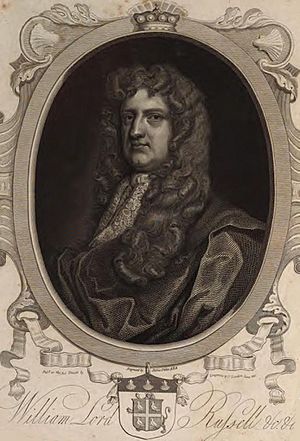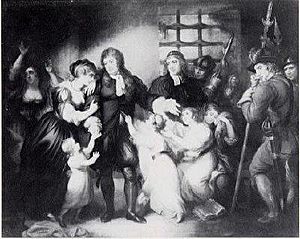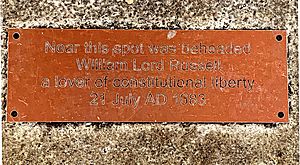William Russell, Lord Russell facts for kids
Quick facts for kids
William Russell
Lord Russell
|
|
|---|---|
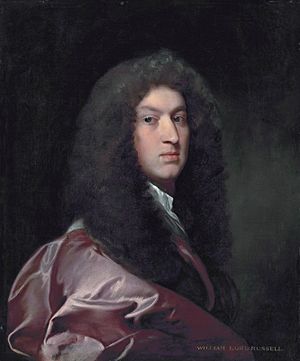
Lord Russell, painted by Gerard Soest
|
|
| Born | 29 September 1639 |
| Died | 21 July 1683 (aged 43) Lincoln's Inn Fields
|
| Cause of death | Execution by beheading |
| Nationality | English |
| Alma mater | Cambridge University |
| Occupation | Member of Parliament |
| Spouse(s) | Rachel Wriothesley |
| Children |
|
| Parent(s) | |
William Russell, Lord Russell (born September 29, 1639 – died July 21, 1683) was an English politician. He was an important leader of the Country Party. This group later became known as the Whigs. During the time of King Charles II, they worked to stop Charles's brother, James, from becoming king. James was openly Catholic, and many people in the House of Commons did not want a Catholic king. Sadly, this led to Lord Russell being executed for treason, which is a very serious crime against the country. This happened almost two years before King Charles died and James became king.
Contents
Early Life and Family
William Russell was born as the third son of William Russell, 5th Earl of Bedford. His mother was Lady Anne Carr. His father later became the Duke of Bedford. When his older brother Francis died in 1679, William gained the special title of Baron Russell. From then on, people called him Lord Russell.
In 1654, William and Francis studied at Cambridge University. After that, they traveled around Europe. They visited cities like Lyon and Geneva and stayed for a while in Augsburg. William wrote about his travels, describing them in a very interesting way. By 1658, they were in Paris. They returned to their family home, Woburn Abbey in Woburn, by December 1659.
Marriage and Connections
When Charles II became king in 1660, a time known as the Restoration, William Russell was chosen as a Member of Parliament for Tavistock. This seat was often held by a member of his family. For many years, Russell was not very active in politics. He mostly focused on court life and did not speak in Parliament until 1674. In 1663 and 1664, he was involved in two duels, getting hurt in the second one.
In 1669, when he was 30, he married Lady Vaughn. She was a widow. Through this marriage, he became connected to the Earl of Shaftesbury, who was married to his wife's cousin. William and Rachel had a very loving and close marriage.
Political Career in Parliament
Lord Russell became much more active in politics when the Country Party was formed. This party was the beginning of the Whig party. They were against the policies of the Cabal, which was a small group of the king's advisors. They also opposed Charles II's friendly approach to France and Catholic policies.
Russell strongly disliked Catholicism, once saying, "I despise such a ridiculous and nonsensical religion." He also deeply loved political freedom. He spoke out against the unfair treatment of Protestant groups called Dissenters. His first recorded speech in Parliament was on January 22, 1674. In it, he criticized several actions of the king's government. These included the Great Stop of the Exchequer (when the government stopped paying its debts) and the attack on the Smyrna fleet. He also spoke about how some of Charles's advisors were taking money from France. Russell also supported actions against the Duke of Buckingham. In 1675, Russell asked the king to remove the Earl of Danby from his royal advisors and to put him on trial.
On February 15, 1677, during a debate about a very long break between Parliament sessions, Russell suggested that Parliament should be completely ended. In March 1678, he supported a request for the king to declare war against France. The Country Party disliked James, the Duke of York (the king's brother) and Lord Danby even more than they disliked Louis XIV of France. Because of this, the French king found it easy to make a temporary agreement with Russell and other opposition leaders. They wanted to limit the king's power to harm France. They also wanted to make the king seek friendship with Louis XIV, but only if Louis supported their goals. Russell talked closely with the Marquis de Ruvigny, who was Lady Russell's cousin. Ruvigny came to England with money to give to members of Parliament. However, records show that Russell himself refused to take any money from the French.
The Popish Plot and Monmouth
In 1678, there was a big scare about a supposed "Popish Plot" to murder King Charles II. People believed this plot was meant to help his Catholic brother become king faster. This false alarm seemed to affect Russell more than one might expect from his usual calm nature. Russell joined a small group who hoped that James Scott, 1st Duke of Monmouth ("Monmouth") would become king instead. Monmouth was an illegitimate son of Charles, but he was seen as a leader for Protestant interests. This was a political mistake. However, Russell later spoke secretly with William of Orange. William and his wife Mary would become king and queen five years after Russell's death.
Exclusion Debates
On November 4, 1678, Russell asked the King to remove his brother James, the Duke of York, from his personal life and his advisors. This also meant removing him from the line of succession to the throne. Parliament insisted on putting Danby on trial, so the king ended Parliament in December and dissolved it in January. In the next election, Russell was again elected to Parliament. This time he represented Bedfordshire.
The success of the new "party" in the 1679 elections led to Danby being removed from the government. In April 1679, Russell became a member of a new group of advisors to King Charles. Just six days later, Russell suggested creating a bill to protect religion and property if a Catholic person were to become king. In June 1679, he openly criticized (the Duke of) Lauderdale in front of the whole council.
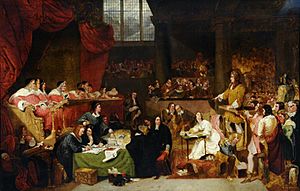
In January 1680, Russell and several other important politicians resigned from the King's council. King Charles accepted their resignations, saying "with all my heart." On June 16, Russell went with Shaftesbury when Shaftesbury accused James of being a Catholic who refused to follow the Church of England. On October 26, Russell spoke in Parliament, asking to stop Catholicism and prevent a Catholic from becoming king. On November 2, at the peak of his influence, he strongly supported the idea of excluding James from the throne. On November 19, he physically carried the bill to exclude James to the House of Lords. He was against any plan that would limit the king's power instead of completely excluding James.
On March 26, 1681, at the parliament held in Oxford, Russell again supported the Exclusion Bill. When Parliament was ended, he went to live privately at his country home, Stratton in Hampshire. It was likely at his request that his chaplain wrote a book defending the idea of resistance in extreme situations.
The Rye House Plot and Trial
Lord Russell was not involved in the plans of the Whig leader Shaftesbury after the election of Tory officials for London in 1682. However, when the city's special rights were taken away in 1683, Russell began to think seriously about how to oppose the King's government. In October 1682, he attended a meeting where people talked about things that could be considered treason. Monmouth, Essex, Hampden, Algernon Sidney, Lord Howard of Escrick (a cousin of Russell's mother), and Sir Thomas Armstrong met at a wine merchant's house. There, they met Richard Rumbold, who owned Rye House, a strong house in Hertfordshire.
This meeting was followed by the failed Rye House Plot. This was a plan to ambush King Charles II and his brother James near Rye House as they returned to London from horse races. However, someone told the government about the plot. Unlike some others involved, Russell refused to escape to Holland. He was accused of promising to help start a rebellion and cause the king's death. On June 26, 1683, he was sent to the Tower of London, where he prepared for his death. Monmouth offered to return to England and be tried if it would help Russell. Essex also refused to run away, fearing it would hurt his friend's chance of escape.
Russell was tried and found guilty of treason. He was sentenced to be hanged, drawn, and quartered. However, King Charles II changed this to death by beheading.
By the rules of that time, when people accused of treason rarely escaped death, Russell received a fair trial. The main judge, Lord Chief Justice Francis Pemberton, even seemed to lean towards finding him not guilty. This upset the King, who removed the judge soon after. Back then, people accused of treason were not allowed to have a lawyer. But in a rare exception, Lady Russell was allowed to act as her husband's secretary during the trial. Even Jeffreys, who was leading the prosecution, acted calmly and respectfully during the trial. He stressed the strong evidence but reminded the jury that no innocent person should lose their life.
After the verdict, Russell's wife and friends tried desperately to save him. They begged the King, the Duke of York, and the French Ambassador for mercy. The French Ambassador told the King that Louis XIV thought this was a case for mercy. James was also willing to listen to Russell's friends. But Charles was firm, saying, "if I do not take his life he will shortly take mine." Russell himself, in requests to Charles and James, offered to live abroad if his life was spared and never again get involved in England's affairs. However, he refused an offer of escape from Cavendish. Lady Russell had a private meeting with the King and knelt before him, but it was no use. Charles, who had shown kindness to former enemies after he became king again, no longer believed in showing mercy to those he saw as his enemies.
Execution and Legacy
Lord Russell spent his last day peacefully in the Tower of London. He spent the morning praying with the Scottish archbishop Alexander Burnet. He was beheaded by Jack Ketch on July 21, 1683, at Lincoln's Inn Fields. People said that Ketch, the executioner, did a very poor job. He later wrote a letter apologizing.
Russell did not confess to plotting to kill the king. He said he knew of no such plot. However, he did admit to planning to start a war. This kind of "mini-invasion" eventually happened and was successful later on. Russell felt disappointed with the justice he received, as he wrote in his last letter. Later, under William III, Russell was officially cleared of the treason charge. This meant his conviction was reversed, and he was pardoned. The evidence against him was considered to be just hearsay (rumors). His pardon is still an official document today.
Later, the Whig party honored him as a hero who was treated unfairly. They believed he was put to death because he tried to stop James from becoming king.
Several people were put on trial and found guilty of seditious libel (publishing writings that encouraged rebellion) for writing about his ghost.
|


